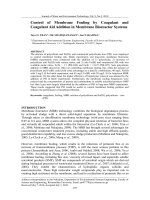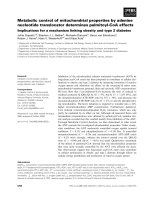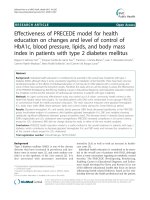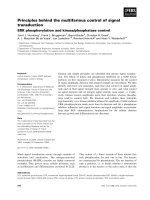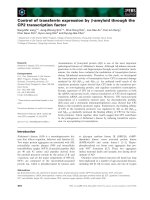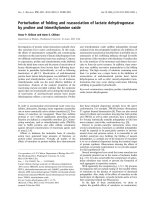Control of Membrane Fouling by Coagulant and Coagulant Aid Addition in Membrane Bioreactor Systems
Bạn đang xem bản rút gọn của tài liệu. Xem và tải ngay bản đầy đủ của tài liệu tại đây (201.32 KB, 11 trang )
Journal of Water and Environment Technology, Vol. 8, No.3, 2010
Control of Membrane Fouling by Coagulant and
Coagulant Aid Addition in Membrane Bioreactor Systems
Tuyet T. TRAN*, Md. SHAFIQUZZAMAN*, Jun NAKAJIMA*
* Department of Environmental Systems Engineering, Faculty of Science and Engineering,
Ritsumeikan University, 1-1-1 Nojihigashi, Kusatsu 525-8577, Japan.
ABSTRACT
The mixture of polysilicate and Fe(III), and commercial polysilicato-iron (PSI) were employed
to control membrane fouling risk. Batch experiments and long-term membrane bioreactor
(MBR) experiments were conducted with the addition of 1) polysilicate, 2) mixtures of
polysilicate and Fe(III) with various ratios, and 3) sole Fe(III) and commercial PSI with two
available molar ratios, Fe/Si = 1:1 (PSI-100) and Fe/Si = 1:0.25 (PSI-025). Sole polysilicate
addition in MBR showed no effect on controlling membrane fouling risk, while the mixture of
polysilicate and Fe(III) could yield some advantages at a specific combination, 90 mg/L Fe(III)
with 5 mg/L Si for batch experiment, and 45 mg/L Fe(III) with 20 mg/L Si for long-term MBR
experiment. On the other hand, the higher efficiency of biopolymer removal was attained by the
addition of PSI in batch experiments. Furthermore, the membrane fouling frequencies were
reduced and the concentrations of protein and carbohydrate in soluble microbial products (SMP
less than 1m) were largely diminished by the addition of PSI in long-term MBR experiments.
These results suggested that PSI would be useful to control membrane fouling problem and
enhance the performance of membrane filtration.
Keywords: coagulants, fouling, MBR, mixture of polysilicate and Fe(III), polysilicato – iron
(PSI).
INTRODUCTION
Membrane bioreactor (MBR) technology combines the biological degradation process
by activated sludge with a direct solid-liquid separation by membrane filtration.
Through micro or ultrafiltration membrane technology (with pore sizes ranging from
0.05 to 0.4 m), MBR system allows the complete physical retention of bacterial flocs
and virtually all suspended solids within the bioreactor (Le-Clech et al., 2006; Tran et
al., 2006; Mishima and Nakajima, 2009). The MBR has brought several advantages for
conventional wastewater treatment process, including stable and high effluent quality,
good disinfection capability, and less excess sludge production (Mishima and Nakajima,
2003; Le-Clech et al., 2006; Meng et al., 2009).
However, membrane fouling, which results in the reduction of permeate flux or an
increase of transmembrane pressure (TMP), is still the most serious problem in this
process (Jarusutthirak and Amy, 2006; Arabi and Nakhal, 2008; Wu et al., 2006; Yu et
al., 2006). According to Zhang et al. (2008), several factors have been found to affect
membrane fouling, including floc size, viscosity of mixed liquor, and especially soluble
microbial products (SMP). SMP are compounds of microbial origin which are derived
during biological processes of wastewater treatment (Drews et al., 2007; Ichihashi et al.,
2006). They exhibit the characteristics of hydrophilic organic colloids and
macromolecules. These high molecular weight compounds play an important role in
creating high resistance on the membrane, and lead to a reduction of permeate flux or an
Address correspondence to Jun Nakajima, Department of Environmental Systems Engineering, Faculty of
Science and Engineering, Ritsumeikan University, Email:
Received May 7, 2010, Accepted July 7, 2010.
- 203 -
increase of TMP (Jarusutthirak and Amy, 2006; Drews et al., 2008; Aquino and Stuckey,
2008). Therefore, SMP is considered as the most important factor causing membrane
fouling (Meng and Yang, 2007).
Almost all colloids found in activated sludge carry negative charge (Zouboulis and
Moussas, 2008). Thus, addition of cations like aluminum-based or iron-based
coagulants can enhance the filterability of the mixed liquor in the MBR because these
ions neutralize the charge of sludge (Fu and Yu, 2007; Xu et al., 2009; Fu et al., 2007;
Song et al., 2008). According to Mishima and Nakajima (2009), the addition of Fe(III)
coagulant was found to have a higher efficiency than that of aluminum sulfate in MBR.
The polyferric coagulant was observed to be more effective than conventional
coagulants (Zouboulis and Moussas, 2008; Fu et al., 2007; Wang and Tang, 2001).
Furthermore, the addition of polyferric coagulant could control both the irreversible
fouling and suspension viscosity (Le-Clech et al., 2006).
Sometimes, coagulant aid was added to Fe(III) to increase the ability of sludge
dewatering, so polysilicate addition to Fe(III) was thought to be also useful to increase
bridge-aggregation ability in MBR system. Therefore, mixture of polysilicate and
Fe(III) was used in this study. Behaviors of these materials on biopolymer (protein and
carbohydrate) removal and fouling reduction were investigated by conducting batch and
long-term MBR experiments. The main goals of adding such modified coagulants were
to increase particle size, and to enhance the aggregation ability of the conventional
coagulants.
MATERIALS AND METHODS
Preparation of coagulants and coagulant aids
Sodium silicate (Na2SiO3, anhydrous) used as coagulant aid was diluted with distilled
water and then neutralized to pH 7.0 by HCl and NaOH solutions. Iron (III) chloride
hexahydrate (FeCl36H2O) used as coagulant was also diluted and mixed with the
diluted sodium silicate solution to get the final mixtures with different ratios of Fe(III)
and polysilicate. Commercial polysilicato-iron (PSI, Suidokiko, Japan) solution with
two available molar ratios, PSI-025 (Fe/Si = 1:0.25) and PSI-100 (Fe/Si = 1:1), was
used as coagulants. They were also diluted with distilled water to get the final solution
in which the concentration of Fe (III) was 45 mg/L.
Batch experiments
The aim of these experiments was to investigate the effect of coagulant and coagulant
aid additions on the biopolymer removal, especially protein and carbohydrate. Herein,
commercial albumin (from egg) and glycogen (from oyster) were diluted to get the
original concentration of protein and carbohydrate at 100 mg/L, respectively. The
commercial albumin or glycogen solution was then respectively mixed with different
coagulants and coagulant aid in 200 ml beaker. After 15 minutes of mixing at 30 rpm by
a jar test apparatus, the mixing solution was filtered through filter paper (1 m pore size,
Advantec 5C) and was measured for protein and carbohydrate concentrations. The
mixing duration (15 minutes) was decided from the results of kinetic batch experiments.
The pH of all solutions of the batch experiments were controlled to 7.0 using HCl and
NaOH solutions during the preparation process.
204
Long-term MBR experiments
Fig. 1 shows the schematic diagram of a typical laboratory-scale MBR experiment.
Each reactor was made of plexiglass and had a designed working volume of 10 L. A flat
sheet membrane made of chlorinated polyethylene (0.4 m nominal pore size and 0.04
m2 filtration area, Kubota, Japan) was submerged into the reactor, which was
intermittently operated under 1.5 h aerobic and 0.5 h anaerobic conditions at 25oC. Air
was supplied from an aeration pipe below the membrane module at 3 L/min to provide
oxygen for biomass growth and to create sufficient turbulence along the membrane
surface. Mixture of concentrated coagulant and its aid or sole polysilicate solution was
added to the reactor for 15 min every 2 h at 1.1 mL/min. Simultaneously, NaHCO3
solution (1.25%) was added at the same flow rate and duration, except for the
experiments with sole polysilicate addition, in order to control the pH. The filtration
was carried out with the flux set at 0.25 m3/m2/day. The suction pump was also
intermittently operated by keeping it on for 1.5 h and off for 0.5 h. The membranes were
washed (physical washing by tap water while wiping the membrane with hand or
chemical washing by submerging the membrane in 0.25% NaOCl solution for 1 to 2 h)
when the pressure of the suction pump decreased to less than -0.03 MPa.
Fig. 1 - Schematic diagram of the long-term MBR experiment.
Table 1 - Components of synthetic wastewater.
Components
Concentration Influent water Concentration
(mg/L)
quality
(mg/L)
Glucose
1233.33
BOD
1000
Sodium L(+)-glutamate 603.33
Nitrogen
50
monohydrate
Phosphorus
25
NaCl
16.67
CaCl2.2H2O
11
MgSO4
10.5
K2HPO4
106.67
KH2PO4
26.67
NaHCO3
105
205
Mixed liquor taken from an actual MBR facility treating domestic wastewater (1,000
population equivalents) in Kusatsu City, Japan, was used in all long-term MBR
experiments. Synthetic wastewater (Table 1) was fed into each reactor at 10 L/day with
1,000 mg/L of biological oxygen demand (BOD), 50 mg/L of nitrogen and 25 mg/L of
phosphorus. The experiments were conducted at a sludge retention time (SRT) of 33
days and the hydraulic retention time (HRT) was almost 24h. The corresponding
concentration of mixed liquor suspended solid (MLSS) in the reactors were around
10,000 to 14,000 mg/L.
Table 2 shows the list of coagulants and/or coagulant aid, which were used in the longterm MBR experiments. Every three MBR was operated simultaneously to clarify and
to compare the behavior among the coagulants and coagulant aid.
Table 2 - Conditions of coagulants and coagulant aid in long-term MBR experiments
Coagulants
Runs
Polysilicate (mg/L)
Fe (mg/L)
PSI-100 (mg Fe/L / mg Si/L)
PSI-025 (mg Fe/L / mg Si/L)
R1 R2 R3 R4 R5 R6 R7 R8
R9
45/12
10
20
10
45
20
45
50
45
45
45/49.5
Analytical methods
Protein and carbohydrate concentrations were measured using Lowry’s method and the
anthrone-sulfuric acid reaction, respectively. Iron and silicate were determined by an
inductively coupled plasma emission spectrometry (SPS 4000, Seiko, Japan) after the
digestion of organics using nitric acid and hydrogen peroxide. The extracellular
polymeric substances (EPS) of the mixed liquor were extracted by steam treatment at
105 oC for 30 minutes (Nakajima and Mishima, 2005). For the SMP <0.4 m and SMP
of 0.4~1 m, measurement of the amount of protein and carbohydrate in the effluent
and mixed liquor filtered by filter paper (1 m pore size, Advantec 5C) was done.
Chemical oxygen demand (COD) was measured using KMnO4 oxidization. Quantitative
analyses of other parameters were carried out according to JIS K0102.
RESULTS AND DISCUSSION
Batch experiments
Biopolymer removal by polysilicate and Fe(III) addition
Fig. 2 shows the results obtained from the batch experiments, which were conducted
using sole polysilicate and different ratios of polysilicate and Fe (III). It can be seen that
without Fe(III) addition the carbohydrate concentration remained stable. However, in
the case of protein, it slightly increased from 85 mg/L to 91 mg/L with 0 and 5 mg/L
polysilicate addition, respectively. After that, it remained stable. Since in neutral media
both the biopolymers and polysilicate carry minus charge (Duan and Gregory, 2003)
they do not react with each other. This suggested that sole polysilicate would have no
effect on the biopolymer removal.
On the other hand, the mixture of Fe(III) and polysilicate worked more effectively on
protein and carbohydrate removal. The removal amount increased according to the
206
increase in Fe(III) concentrations. Particularly, the protein concentrations decreased and
were 85 mg/L, 46 mg/L and 23 mg/L at 0, 45 and 90 mg/L Fe(III) without polysilicate,
respectively. For these conditions, the carbohydrate concentrations were found to be 95,
55 and 34 mg/L, respectively. The optimum combination of Fe(III) and polysilicate
seemed to exist at 5 mg/L polysilicate and 90 mg/L Fe(III) with protein and
carbohydrate concentrations of 9 and 32 mg/L, respectively. Therefore, the presence of
polysilicate in the mixtures seemed to serve as a bridge to enhance the aggregation of
conventional Fe(III) coagulant.
Protein (mg/L)
120
100
80
60
40
Fe(III) 0 mg/L
20
Carbohydrate (mg/L)
0
120 0
Fe(III) 45 mg/L
Fe(III) 90 mg/L
5
10
100
15 20 25 30 35
Polysilicate (mg/L)
40
45
50
80
60
Fe(III) 0 mg/L
40
Fe(III) 45 mg/L
20
Fe(III) 90 mg/L
0
0
5
10
15
20 25 30 35
Polysilicate (mg/L)
40
45
50
Fig. 2 - Biopolymer removal by sole Fe(III), mixtures of polysilicate addition.
(Error bars show the standard deviation of 3 samples)
Biopolymer removal by PSI addition
Table 3 shows the results of protein and carbohydrate removals by PSI-025 (45 mg Fe/L
and 12 mg Si/L) and PSI-100 (45 mg Fe/L and 49.5 mg Si/L) additions. The standard
deviations were calculated from 3 samples. Protein and carbohydrate removals were
about 37% - 48% and 25% - 36%, respectively. The biopolymer removal by PSI-025
addition was significantly higher than PSI-100 addition (p = 0.022). However, both PSI
additions showed effectiveness in biopolymer removal.
Table 3 - Protein and carbohydrate removal by PSI additions (%)
No addition PSI-100 addition PSI-025 addition
Protein
0
37 3.8
48 3.6
Carbohydrate
0
25 1.5
36 0.6
207
Long-term MBR experiments
Effluent water quality
The BOD and COD removal in R1 to R9 were almost stable at 99.7% to 99.9% and
96.7% to 98.7%, respectively. These values indicated that BOD and COD were removed
effectively due to the performance of membrane filter and the biological degradation
process of activated sludge in MBR and there was no significant difference among 9
runs.
TMP profiles of MBR experiments with polysilicate addition
Fig. 3 shows the behavior of polysilicate in controlling membrane fouling in three MBR
systems (R1, R2, and R3). TMP was increased by membrane clogging and recovered by
physical washing. The concentrations of sole polysilicate addition employed in the
current experiments were 0 mg/L (R1), 10 mg/L (R2), and 20 mg/L (R3). It can be seen
that the fouling frequency found in the three MBR systems were almost similar during
the 35 days of operation. Moreover, the mean periods per one washing in R1, R2, and
R3 were 1.0 0.5 day, 0.63 0.4 day, and 0.88 0.6 day, respectively. These results
suggested that sole polysilicate addition has no effect on membrane fouling mitigation.
0.06
TMP (Mpa)
a)
0.04
0.02
0.00
0.06
TMP (Mpa)
b)
0.04
0.02
0.00
c)
TMP (Mpa)
0.06
0.04
0.02
0.00
0
5
10
15
20
25
30
Time (days)
Fig. 3 - TMP profiles of MBR at a) R1, b) R2 and c) R3.
208
35
TMP profiles of MBR experiments with Fe(III) and polysilicate combinations addition
The fouling frequencies shown in Fig. 4 resulted when mixtures of Fe(III) and
polysilicate were used (R4, R5, R6). In the case of R5, where the mixture contained 20
mg Si/L and 45 mg Fe(III)/L, the clogging frequency seemed to be decreased as
compared to the others. Moreover, the mean fouling periods of R4, R5, R6 and R7 (sole
Fe(III) addition) were also calculated. The longest period, 1.52 days per one washing,
was obtained in R5 while in other cases it was less than 1 day. This result suggested that
adding polysilicate and Fe(III) mixture would bring better effect to mitigate membrane
fouling problems under suitable ratio and condition. In this study, the combination of 20
mg Si/L and 45 mg Fe(III)/L could give better results than the others.
0.06
TMP (Mpa)
a)
0.04
0.02
0.00
0.06
TMP (Mpa)
b)
0.04
0.02
0.00
c)
TMP (Mpa)
0.06
0.04
0.02
0.00
0
5
10
15
20
25
30
35
Time (days)
Fig. 4 - TMP profiles of MBR at a) R4, b) R5 and c) R6.
TMP profiles of MBR experiments with PSI addition
Fig. 5 shows the fouling frequency in MBR systems when PSI and sole Fe(III)
coagulant were used (R7, R8, R9). From the start of PSI addition, the fouling
frequencies in R8 (PSI-100) and R9 (PSI-025) had decreased gradually. After 20 days,
they completely decreased as shown in Fig. 5. The mean periods per one washing in R7,
R8, and R9 were 0.91 0.4 day, 13.99 8.1 days, and 34.97 3.28 days, respectively.
This suggested that using PSI as coagulant resulted to higher efficiency in mitigating
209
membrane fouling risk than using sole Fe(III). The decrease of fouling frequency would
be caused by the change of biopolymer concentrations as shown in the batch experiment
results. Therefore, the biopolymers in R7, R8, and R9 were measured.
0.05
a)
TMP (MPa)
0.04
0.03
0.02
0.01
0.00
0.05
b)
TMP (MPa)
0.04
0.03
0.02
0.01
0.00
c)
TMP (MPa)
0.05
0.04
0.03
0.02
0.01
0.00
20
30
40
50
60
70
80
90
Time (days)
Fig. 5 - TMP profiles of MBR at a) R7, b) R8 and c) R9.
Change of biopolymer in MBRs with PSI addition
Previous studies (Le-Clech et al., 2006; Arabi and Nakhla, 2008; Zhang et al., 2008;
Mishima and Nakajima, 2009) have reported that the biopolymer contents in EPS and
SMP were the main factor causing membrane fouling problem. Therefore, the
biopolymer contents of EPS and SMP were also measured.
As shown in Fig. 6, biopolymer concentrations, especially carbohydrate in SMP (both
fractions of <0.4 m and 1-0.4 m), were largely decreased by PSI-100 and PSI-025
addition. On the contrary, biopolymer concentrations in activated sludge and EPS had
small differences with the addition of Fe(III), PSI-100, and PSI-025. It suggested that
the PSI had affected and coagulated the SMP in the reactors and prevented the
membrane from fouling. From these results, it can be stated that in the case of PSI
addition, a strong correlation between membrane fouling (TMP) and the biopolymer
210
concentrations was obtained.
Total (mg/L)
8000
Protein
Carbohydrtae
Carbohydrate
6000
4000
2000
0
EPS (mg/L)
1500
Fe(III)
PSI-100
PSI-025
Fe(III)
PSI-100
PSI-025
Protein
Carbohydrate
Carbohydrtae
1000
500
SMP (0.4~1 µm) (mg/L)
0
300
Protein
Carbohydrate
Carbohydrtae
200
100
0
SMP (< 0.4 µm) (mg/L)
Fe(III)
PSI-100
PSI-025
Protein
Carbohydrate
Carbohydrtae
20
10
0
Fe(III)
PSI-100
PSI-025
Fig. 6 - Protein and carbohydrate concentrations in R7, R8 and R9.
(Error bars show the standard deviation of 21 samples)
CONCLUSIONS
This paper investigated the effects of the coagulants and coagulant aid additions in
controlling membrane fouling risk in MBR. A number of batch experiments and longterm MBR experiments were conducted and the results obtained are as follows:
Sole polysilicate addition in MBR showed no effect on the removal of biopolymer in
batch experiments and on the mitigation of membrane fouling risk in MBRs.
211
Mixture of polysilicate and Fe(III) with a suitable ratio gave positive effect, as
compared to sole polysilicate or sole Fe(III) addition, on biopolymer removal and
membrane fouling mitigation. This was because the presence of polysilicate served as a
bridge to enhance the aggregation of Fe(III) coagulant and so the control of membrane
fouling was more effective.
PSI effectively reduced biopolymer concentrations and membrane fouling in MBR. The
reduction of membrane fouling by PSI addition was caused by the coagulation of SMP.
ACKNOWLEDGEMENTS
The authors would like to thank Mr. N. Shimada and Mr. Iori Mishima. Moreover, since
this work was partly supported by Open Research Center Project for Private
Universities matching fund subsidy from MEXT, 2007-2011, the authors are equally
grateful for the research aid.
REFERENCES
Aquino S. F. and Stuckey D. C. (2008). Integrated model of the production of soluble
microbial products (SMP) and extracellular polymeric substances (EPS) in
anaerobic chemostats during transient conditions, Biochemical Engineering Journal,
38, 138-146.
Arabi S. and Nakhal G. (2008). Impact of protein/carbohydrate ratio in the feed
wastewater on the membrane fouling in membrane bioreactors, Journal of
Membrane Science, 324, 142-150.
Drews A., Mante J., Iversen V., Vocks M., Lesjean B. and Kraume M. (2007). Impact of
ambient conditions on SMP elimination and rejection in MBRs, Water Research, 41,
3850-3858.
Drews A., Vocks M., Bracklow U., Iversen V. and Kraume M. (2008). Does fouling in
MBRs depend on SMP? Desalination, 231, 141-149.
Duan J. and Gregory J. (2003). Coagulation by hydrolysing metal salts, Adv. Coll. Interf.
Sci. 100-102, 475-502.
Fu Y. and Yu S. L. (2007). Characterization and coagulation performance of solid polysilicic-ferric (PSF) coagulant, Journal of Non-crystalline Solid, 353, 2206-2213.
Fu Y., Yu S. L., Yu Y. Z., Qiu L. P., Hui B. (2007). Reaction mode between Si and Fe
and evaluation of optimal species in poly-silicic-ferric coagulant, Journal of
Environmental Sciences, 19, 678-688.
Ichihashi O., Satoh H., and Mino T. (2006). Effect of soluble microbial products on
microbial metabolisms related to nutrient removal, Water Research, 40, 1627 – 1633.
Jarusutthirak C. and Amy G. (2006). Role of soluble microbial products (SMP) in
membrane fouling and flux decline, Environ. Sci. Technol., 40, 969-974.
Le-Clech P., Chen V. and Fane T. A. G. (2006). Fouling in membrane bioreactors used in
wastewater treatment, Journal of Membrane Science, 284, 17-53.
Meng F. and Yang F. (2007). Fouling mechanisms of deflocculated sludge, normal
sludge, and bulking sludge in membrane bioreactor, Journal of Membrane Science,
305, 48-56.
Meng F., Chae S. R., Drews A., Kraume M., Shin H. S., and Yang F. (2009). Recent
advances in membrane bioreactors (MBRs): Membrane fouling and membrane
212
material, Water Research, 43, 1489-1512.
Mishima I. and Nakajima J. (2003). Coagulants and Phosphorus Behavior in Activated
Sludge Process for Phosphorus Removal, Journal of Japan Society on Water
Environment, 26(2), 99-104.
Mishima I. and Nakajima J. (2009). Control of Membrane fouling by Coagulant
Addition in Membrane Bioreactor Process, Water Science and Technology, 59(7),
1255-1262.
Nakajima J. and Mishima I. (2005). Measurement of foam quality of activated sludge in
MBR, Acta Hydrochim. Hydrobiol, 33(3), 232-239.
Song K. G., Kim Y., and Ahn K. H. (2008). Effect of coagulant addition on membrane
fouling and nutrient removal in a submerged membrane bioreactor, Desalination,
221, 467 – 474.
Tran T., Gray S., Naughton R., and Bolto B. (2006). Polysilicato-iron for improved
NOM removal and membrane performance, Journal of Membrane Science, 280,
560-571.
Wang D. and Tang H. (2001). Modified inorganic polymer flocculant–PFSi: Its
preparation, characterisation and coagulation behavior, Water Research, 35(14),
3418-3428.
Wu J., Chen F., Huang X., Geng W., and Wen X. (2006). Using inorganic coagulants to
control membrane fouling in a submerged membrane bioreactor, Desalination, 197,
124-136.
Xu X., Yu S. L., Shi W., Jiang Z. Q and Wu C. (2009). Effect of acid medium on the
coagulation efficiency of polysilicate-ferric (PSF) - A new kind of inorganic
polymer coagulant, Separation and Purification Technology, 66, 486-491.
Yu S. L., Zhao F. B., Zhang X. H., Jing G. L., and Zhen X. H., (2006). Effect of
components in activated sludge liquor on membrane fouling in a submerged
membrane bioreactor, Journal of Environmental Science, 18(5), 897-902.
Zhang H. F., Sun B. S., Zhao X. H., and Gao Z. H. (2008). Effect of ferric chloride on
fouling in membrane bioreactor, Separation and Purification Technology, 63, 341347.
Zouboulis A. I. and Moussas P. A. (2008). Polyferric silicate sulfate (PFSiS):
Preparation, characterisation and coagulation behavior, Desalination, 224, 307-316.
213

